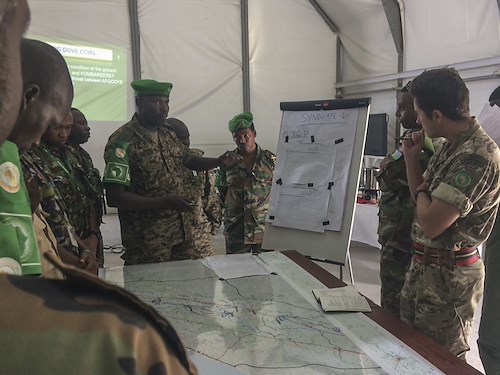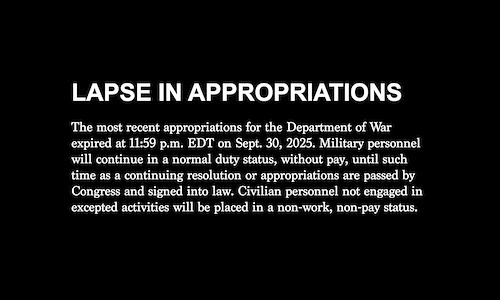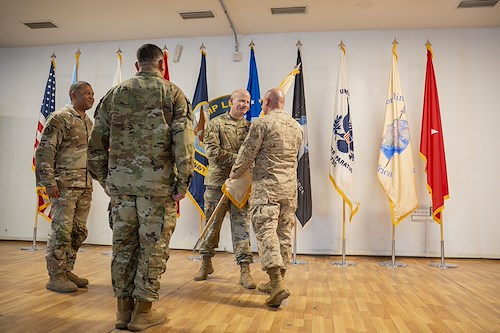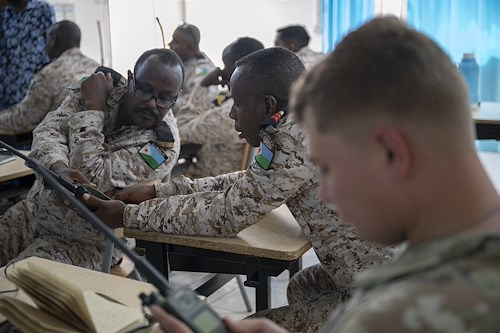Gallery contains 3 images
×
Photo 1 of 3
AMISOM intel-gathering capabilities strengthened through U.S., British assistance
British Army Capt. Doug Collett (far right), U.K. Mission Support Team member, gives instruction during an intelligence, surveillance and reconnaissance (ISR) course in Mogadishu, Somalia, Aug. 7, 2017. Soldiers from five countries supporting African Union Mission in Somalia are taking the British-led ISR course to improve their intelligence-gathering capabilities in the fight against violent extremist organizations like al-Shabaab in East Africa. (Photo courtesy U.S. Air Force Capt. Brian Hurt/Released)
Photo by: Tech. Sgt. Joe Harwood
Photo 2 of 3
AMISOM intel-gathering capabilities strengthened through U.S., British assistance
U.S. Air Force Capt. Brian Hurt, Combined Joint Task Force-Horn of Africa Intelligence Directorate collection manager, instructs a class during an intelligence, surveillance and reconnaissance (ISR) course in Mogadishu, Somalia, Aug. 7, 2017. Soldiers from five countries supporting African Union Mission in Somalia are taking the British-led ISR course to improve their intelligence-gathering capabilities in the fight against violent extremist organizations like al-Shabaab in East Africa. (Photo courtesy U.S. Air Force Capt. Brian Hurt/Released)
Photo by: Tech. Sgt. Joe Harwood
Photo 3 of 3
AMISOM intel-gathering capabilities strengthened through U.S., British assistance
U.S. Air Force Capt. Brian Hurt, Combined Joint Task Force-Horn of Africa Intelligence Directorate collection manager, advises and assist during an intelligence, surveillance and reconnaissance (ISR) course in Mogadishu, Somalia, Aug. 7, 2017. Soldiers from five countries supporting the African Union Mission in Somalia are taking the British-led ISR course to strengthen efforts countering violent extremist organizations like al-Shabaab within East Africa. (Photo courtesy U.S. Air Force Capt. Brian Hurt/Released)
Photo by: Tech. Sgt. Joe Harwood
CAMP LEMONNIER, Djibouti – African Union Mission in Somalia (AMISOM) troops are making strides in improving their intelligence-gathering capabilities in the fight against violent extremist organizations like al-Shabaab following a recent month-long intelligence, surveillance and reconnaissance (ISR) course taught by both U.S. and British military personnel.
The training took place at the Mogadishu International Airport in Mogadishu, Somalia. Students from the militaries of the five African nations contributing troops to AMISOM – Uganda, Kenya, Burundi, Djibouti and Ethiopia – participated in the training.
The British-led course, which is expected to graduate nearly two-dozen students on Aug. 25, 2017, incorporated instruction from a Combined Joint Task Force-Horn of Africa (CJTF-HOA) Air Force captain, who both taught some of the course material and advised on course curriculum.
The training was in preparation for planned efforts of the U.S. State Department to provide a remotely-piloted aircraft (RPA) to assist in AMISOM efforts to plan and execute operations to against al-Shabaab in the Somalia. The dates are yet to be determined when the system will be provided but the course is intended to give them an understanding of how the ISR capability can be applied to better prepare them in deploying this new tool.
“While British Army Capt. Doug Collett is the primary instructor of the four week course, there was a portion that focused on tasking ISR assets, which I do for CJTF-HOA and so I was asked to join and offer some insight on that,” said U.S. Air Force Capt. Brian Hurt, CJTF-HOA Intelligence Directorate’s collection manager. “I instructed them for a couple of blocks focusing on my area of expertise and then advised and assisted them with course structure and curriculum for the remainder of the week.”
Hurt assisted in the capstone exercise for the week, during which students were given a scenario and formulated a plan and justification to deploy a RPA. After working as a team to come up with their plan, they practiced presenting that it to leadership.
“The capstone is designed to test their understanding of what they have been taught throughout the week. This was their first exercise and they did a really great job,” added Hurt. “They have some areas to improve on and some further technical training in the next block that they will apply when given another scenario with a little more complexity.”
The intent of the combined efforts of CJTF-HOA and partner nations is to assist Somalia National Security Forces in becoming a self-supporting force capable of securing the area and deterring the spread of violent extremism. Efficient and proper use of ISR capabilities give an advantage to ground efforts, helping ensure success of stability in the region.
“The ISR training reinforces CJTF-HOA’s commitment to helping improve AMISOM's capability to plan and collect against their security threats in Somalia,” said U.S. Army Col. Remso J. Martinez, director of CJTF-HOA’s Intelligence Directorate.
Hurt applauded the AMISOM students’ enthusiasm and willingness to learn.
“There is a little bit of a language barrier in a course full of so many different countries' military members,” he said. “They really showed interest in what they were learning. You could see the excitement as they understood how they could apply this in their continued fight against violent extremism.”













